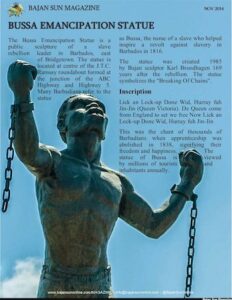
Bussa Emancipation Statue,
St. Michael Parish
*The Bussa Rebellion began on April 14, 1816. Lasting three days, it was the largest slave revolt in Barbadian history.
The rebellion, which took its name from the African slave Bussa, who led it, was the first of three mass slave rebellions in the British West Indies. It was eventually defeated by the colonial militia and shook public faith in slavery in the years before the abolition of slavery in the British Empire and the emancipation of former slaves.
Barbados was a central commercial point to which slaves from the Gold Coast were imported before further dispersal to other British colonies such as Jamaica and British Guiana. Enslaved people were imported from the Gold Coast to Barbados from the 17th century to the early 19th century. The slave revolt on April 14, 1816, in Barbados was led by an enslaved man named Bussa. Bussa was born a free African man in West Africa Igbo, captured by African merchants, sold to European slave traders, and transported to Barbados in the late 18th century as a slave, where under the Barbados Slave Code, slavery had been legal since 1661.
Records show a slave named "Bussa" was a ranger (a head officer among the slaves) on "Bayley's Plantation" in the parish of Saint Philip around the time of the rebellion. This position would have given Bussa more freedom of movement than the average slave and made planning and coordinating the rebellion easier. The revolts arose at a time when the British Parliament was working on schemes to improve the conditions of slaves in the Caribbean. Preparation for this rebellion began soon after the House of Assembly discussed and rejected the Imperial Registry Bill in November 1815, which would have registered West Indian slaves. Historians believe that slaves interpreted some of the parliamentary proposals as preparatory to emancipation and acted when emancipation was rejected.
Among his collaborators were freemen, as well as other slaves, drivers, and artisans. The planning was at several sugar estates, including Bailey's plantation, where it began. By February 1816, Bussa, now an African driver, and his collaborators decided to start the revolt on Easter Sunday. Bussa commanded some 400 rebels, men and women, mostly Creole, born in the islands. He was killed in battle; his forces continued the fight until the colonial militia defeated them. The rebellion failed, but its influence was significant to the future of Barbados. It was followed by the Demerara rebellion of 1823 and the Baptist War in Jamaica in 1831–1832; these are often called the "late slave rebellions."
The Bussa's Rebellion, along with other persistent slave rebellions throughout the Caribbean, had given the British Colonial government a further incentive to pass and enact the Slavery Abolition Act of 1833, officially abolishing slavery as an institution in all of its Caribbean territories. Bussa remains a popular figure in Barbados. In 1985, the Emancipation Statue was unveiled in Haggatt Hall in the parish of St Michael. Many Barbadians attributed the statue to Bussa and nicknamed it 'Bussa's Statue.' In 1998, the Parliament of Barbados named Bussa as one of the eleven National Heroes of Barbados.